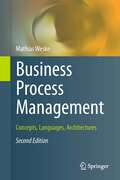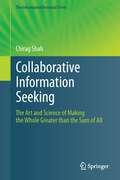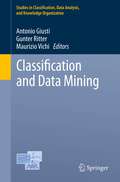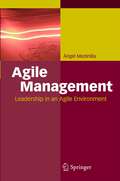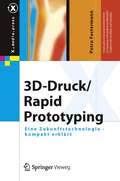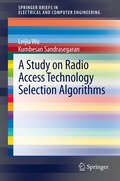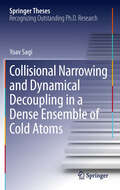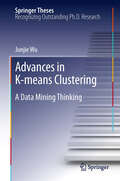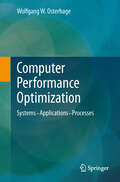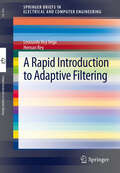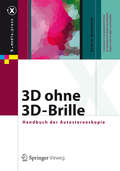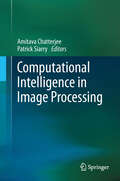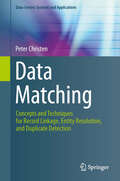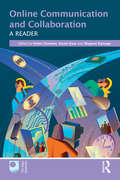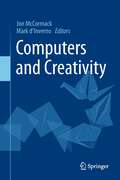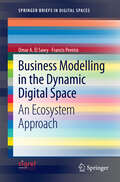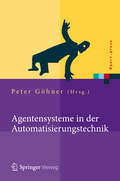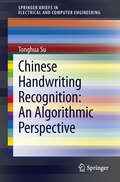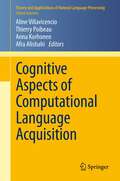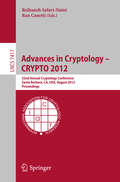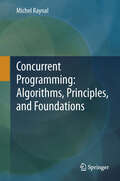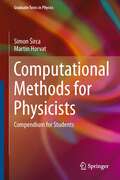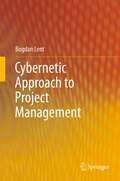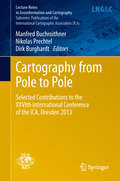- Table View
- List View
Business Process Management: Concepts, Languages, Architectures (Lecture Notes in Computer Science #3080)
by Mathias WeskeBusiness process management is usually treated from two different perspectives: business administration and computer science. While business administration professionals tend to consider information technology as a subordinate aspect in business process management for experts to handle, by contrast computer science professionals often consider business goals and organizational regulations as terms that do not deserve much thought but require the appropriate level of abstraction. Matthias Weske argues that all communities involved need to have a common understanding of the different aspects of business process management. To this end, he details the complete business process lifecycle from the modeling phase to process enactment and improvement, taking into account all different stakeholders involved. After starting with a presentation of general foundations and abstraction models, he explains concepts like process orchestrations and choreographies, as well as process properties and data dependencies. Finally, he presents both traditional and advanced business process management architectures, covering, for example, workflow management systems, service-oriented architectures, and data-driven approaches. In addition, he shows how standards like WfMC, SOAP, WSDL, and BPEL fit into the picture. This textbook is ideally suited for classes on business process management, information systems architecture, and workflow management. This 2nd edition contains major updates on BPMN Version 2 process orchestration and process choreographies, and the chapter on BPM methodologies has been completely rewritten. The accompanying website www.bpm-book.com contains further information and additional teaching material.
Collaborative Information Seeking: The Art and Science of Making the Whole Greater than the Sum of All (The Information Retrieval Series #34)
by Chirag ShahToday's complex, information-intensive problems often require people to work together. Mostly these tasks go far beyond simply searching together; they include information lookup, sharing, synthesis, and decision-making. In addition, they all have an end-goal that is mutually beneficial to all parties involved. Such "collaborative information seeking" (CIS) projects typically last several sessions and the participants all share an intention to contribute and benefit. Not surprisingly, these processes are highly interactive. Shah focuses on two individually well-understood notions: collaboration and information seeking, with the goal of bringing them together to show how it is a natural tendency for humans to work together on complex tasks. The first part of his book introduces the general notions of collaboration and information seeking, as well as related concepts, terminology, and frameworks; and thus provides the reader with a comprehensive treatment of the concepts underlying CIS. The second part of the book details CIS as a standalone domain. A series of frameworks, theories, and models are introduced to provide a conceptual basis for CIS. The final part describes several systems and applications of CIS, along with their broader implications on other fields such as computer-supported cooperative work (CSCW) and human-computer interaction (HCI). With this first comprehensive overview of an exciting new research field, Shah delivers to graduate students and researchers in academia and industry an encompassing description of the technologies involved, state-of-the-art results, and open challenges as well as research opportunities.
Classification and Data Mining (Studies in Classification, Data Analysis, and Knowledge Organization #0)
by Maurizio Vichi Antonio Giusti Gunter RitterThis volume contains both methodological papers showing new original methods, and papers on applications illustrating how new domain-specific knowledge can be made available from data by clever use of data analysis methods. The volume is subdivided in three parts: Classification and Data Analysis; Data Mining; and Applications. The selection of peer reviewed papers had been presented at a meeting of classification societies held in Florence, Italy, in the area of "Classification and Data Mining".
Agile Management: Leadership in an Agile Environment
by Ángel MedinillaIf you have tried to implement Agile in your organization, you have probably learned a lot about development practices, teamwork, processes and tools, but too little about how to manage such an organization. Yet managerial support is often the biggest impediment to successfully adopting Agile, and limiting your Agile efforts to those of the development teams while doing the same old-style management will dramatically limit the ability of your organization to reach the next Agile level. Ángel Medinilla will provide you with a comprehensive understanding of what Agile means to an organization and the manager's role in such an environment, i.e., how to manage, lead and motivate self-organizing teams and how to create an Agile corporate culture. Based on his background as a "veteran" Agile consultant for companies of all sizes, he delivers insights and experiences, points out possible pitfalls, presents practical approaches and possible scenarios, also including detailed suggestions for further reading. If you are a manager, team leader, evangelist, change agent (or whatever nice title) and if you want to push Agile further in your organization, then this is your book. You will read how to change the paradigm of what management is about: it is not about arbitrary decisions, constant supervision and progress control, and the negotiation of changing requirements. It is about motivation, self-organization, responsibility, and the exploitation of all project stakeholders' knowledge. We live in a different world than the one that most management experts of the 20th century describe, and companies that strive for success and excellence will need a new kind of manager - Agile managers.
3D-Druck/Rapid Prototyping: Eine Zukunftstechnologie - kompakt erklärt (X.media.press)
by Petra FastermannImmer mehr Kreative nutzen die Möglichkeit, eigene dreidimensionale Objekte in Kunststoff, Metall oder Keramik schnell und preisgünstig herstellen zu lassen. Der 3D-Druck ist eine revolutionäre Technologie, die dieVerwirklichung von Ideen ermöglicht. 3D-Drucker werden immer kleiner und leistungsstärker und damit bürotauglicher. Eine umfassende Beschreibung dieser Zukunftstechnologie bietet dieses praxisnahe und anwenderorientierte Buch. Dabei hilft es mit Tipps und Hinweisen bei der Auswahl des optimalen CAD-Programms und 3D-Druckers.
A Study on Radio Access Technology Selection Algorithms (SpringerBriefs in Electrical and Computer Engineering)
by Leijia Wu Kumbesan SandrasegaranThis book discusses the basic idea of Common Radio Resource Management (CRRM), especially on the Radio Access Technologies selection part of CRRM. It introduces two interaction functions (information reporting function and RRM decision support function) and four interaction degrees (from low to very high) of CRRM. Four possible CRRM topologies (CRRM server, integrated CRRM, Hierarchical CRRM, and CRRM in user terminals) are described. The book presents different Radio Access Technologies selection algorithms, including single criterion and multiple criteria based algorithms are presented and compares them. Finally, the book analyses the advantages and disadvantages of the different selection algorithms.
Collisional Narrowing and Dynamical Decoupling in a Dense Ensemble of Cold Atoms (Springer Theses)
by Yoav SagiUltra-cold atomic ensembles have emerged in recent years as a powerful tool in many-body physics research, quantum information science and metrology. This thesis presents an experimental and theoretical study of the coherent properties of trapped atomic ensembles at high densities, which are essential to many of the aforementioned applications. The study focuses on how inter-particle interactions modify the ensemble coherence dynamics, and whether it is possible to extend the coherence time by means of external control. The thesis presents a theoretical model which explains the effect of elastic collision of the coherence dynamics and then reports on experiments which test this model successfully in the lab. Furthermore, the work includes the first implementation of dynamical decoupling with ultra-cold atomic ensembles. It is demonstrated experimentally that by using dynamical decoupling the coherence time can be extended 20-fold. This has a great potential to increase the usefulness of these ensembles for quantum computation.
Advances in K-means Clustering: A Data Mining Thinking (Springer Theses)
by Junjie WuNearly everyone knows K-means algorithm in the fields of data mining and business intelligence. But the ever-emerging data with extremely complicated characteristics bring new challenges to this "old" algorithm. This book addresses these challenges and makes novel contributions in establishing theoretical frameworks for K-means distances and K-means based consensus clustering, identifying the "dangerous" uniform effect and zero-value dilemma of K-means, adapting right measures for cluster validity, and integrating K-means with SVMs for rare class analysis. This book not only enriches the clustering and optimization theories, but also provides good guidance for the practical use of K-means, especially for important tasks such as network intrusion detection and credit fraud prediction. The thesis on which this book is based has won the "2010 National Excellent Doctoral Dissertation Award", the highest honor for not more than 100 PhD theses per year in China.
Computer Performance Optimization: Systems - Applications - Processes
by Wolfgang W. OsterhageComputing power performance was important at times when hardware was still expensive, because hardware had to be put to the best use. Later on this criterion was no longer critical, since hardware had become inexpensive. Meanwhile, however, people have realized that performance again plays a significant role, because of the major drain on system resources involved in developing complex applications. This book distinguishes between three levels of performance optimization: the system level, application level and business processes level. On each, optimizations can be achieved and cost-cutting potentials can be identified. The book presents the relevant theoretical background and measuring methods as well as proposed solutions. An evaluation of network monitors and checklists rounds out the work.
A Rapid Introduction to Adaptive Filtering (SpringerBriefs in Electrical and Computer Engineering)
by Hernan Rey Leonardo Rey VegaIn this book, the authors provide insights into the basics of adaptive filtering, which are particularly useful for students taking their first steps into this field. They start by studying the problem of minimum mean-square-error filtering, i.e., Wiener filtering. Then, they analyze iterative methods for solving the optimization problem, e.g., the Method of Steepest Descent. By proposing stochastic approximations, several basic adaptive algorithms are derived, including Least Mean Squares (LMS), Normalized Least Mean Squares (NLMS) and Sign-error algorithms. The authors provide a general framework to study the stability and steady-state performance of these algorithms. The affine Projection Algorithm (APA) which provides faster convergence at the expense of computational complexity (although fast implementations can be used) is also presented. In addition, the Least Squares (LS) method and its recursive version (RLS), including fast implementations are discussed. The book closes with the discussion of several topics of interest in the adaptive filtering field.
3D ohne 3D-Brille: Handbuch der Autostereoskopie (X.media.press)
by Armin GrasnickSeit dem kommerziellen Erfolg des 3D-Blockbusters ,,Avatar" im Jahr 2009 kommen immer mehr 3D-Filme und 3D-Fernseher auf den Markt. Mittlerweile gibt es Autostereoskopie-Verfahren, bei denen Zuschauer keine 3D-Brille mehr benötigen. In dem Band werden die derzeit verfügbaren Technologien der Autostereoskopie, ihre Funktionsweise, Anwendung und Limitierung allgemeinverständlich beschrieben. Zu jeder Technologie liefert der Band Anleitungen und Beispiele für die Erstellung von 3D-Inhalten. Alle Tools sind auf der begleitenden Internetseite verfügbar.
Computational Intelligence in Image Processing
by Patrick Siarry Amitava ChatterjeeComputational intelligence based techniques have firmly established themselves as viable, alternate, mathematical tools for more than a decade. They have been extensively employed in many systems and application domains, among these signal processing, automatic control, industrial and consumer electronics, robotics, finance, manufacturing systems, electric power systems, and power electronics. Image processing is also an extremely potent area which has attracted the attention of many researchers who are interested in the development of new computational intelligence-based techniques and their suitable applications, in both research problems and in real-world problems. Part I of the book discusses several image preprocessing algorithms; Part II broadly covers image compression algorithms; Part III demonstrates how computational intelligence-based techniques can be effectively utilized for image analysis purposes; and Part IV shows how pattern recognition, classification and clustering-based techniques can be developed for the purpose of image inferencing. The book offers a unified view of the modern computational intelligence techniques required to solve real-world problems and it is suitable as a reference for engineers, researchers and graduate students.
Data Matching: Concepts and Techniques for Record Linkage, Entity Resolution, and Duplicate Detection (Data-Centric Systems and Applications)
by Peter ChristenData matching (also known as record or data linkage, entity resolution, object identification, or field matching) is the task of identifying, matching and merging records that correspond to the same entities from several databases or even within one database. Based on research in various domains including applied statistics, health informatics, data mining, machine learning, artificial intelligence, database management, and digital libraries, significant advances have been achieved over the last decade in all aspects of the data matching process, especially on how to improve the accuracy of data matching, and its scalability to large databases. Peter Christen's book is divided into three parts: Part I, "Overview", introduces the subject by presenting several sample applications and their special challenges, as well as a general overview of a generic data matching process. Part II, "Steps of the Data Matching Process", then details its main steps like pre-processing, indexing, field and record comparison, classification, and quality evaluation. Lastly, part III, "Further Topics", deals with specific aspects like privacy, real-time matching, or matching unstructured data. Finally, it briefly describes the main features of many research and open source systems available today. By providing the reader with a broad range of data matching concepts and techniques and touching on all aspects of the data matching process, this book helps researchers as well as students specializing in data quality or data matching aspects to familiarize themselves with recent research advances and to identify open research challenges in the area of data matching. To this end, each chapter of the book includes a final section that provides pointers to further background and research material. Practitioners will better understand the current state of the art in data matching as well as the internal workings and limitations of current systems. Especially, they will learn that it is often not feasible to simply implement an existing off-the-shelf data matching system without substantial adaption and customization. Such practical considerations are discussed for each of the major steps in the data matching process.
Online Communication and Collaboration: A Reader
by Helen Donelan Karen Kear Magnus RamageCommunication and collaboration via the Internet has risen to great prominence in recent years, especially with the rise of social networking, Web 2.0 and virtual worlds. Many interesting and worthwhile studies have been conducted on the technology involved and the way it is used and shaped by its user communities. From some of the more popular coverage of these interactions, it might be thought that these are new phenomena. However, they draw on a rich heritage of technologies and interactions. Online communication and collaboration presents a very timely set of articles that cover a range of different perspectives upon these themes, both classic and contemporary. It is unusually broad in the range of technologies it considers - many books on these topics cover only a few forms of collaboration technology - and in considering well-established technologies as well as recent ones. It blends academic and popular articles to combine scholarly rigour with readability. The book is divided into eight sections, covering the foundations of online communication and collaboration, together with current collaboration technologies such as wikis, instant messaging, virtual worlds and social network sites. These modern communication tools are considered in terms of their interactions but also looking back at lessons to be learnt from their technological 'ancestors'. The book also contains an extended case study of online collaboration, taking open-source software as its example. Online communication and collaboration will be of relevance in a wide range of higher education courses in fields related to soft computing, information systems, cultural and media studies, and communications theory.
Computers and Creativity
by Jon Mccormack Mark D’invernoThis interdisciplinary volume introduces new theories and ideas on creativity from the perspectives of science and art. Featuring contributions from leading researchers, theorists and artists working in artificial intelligence, generative art, creative computing, music composition, and cybernetics, the book examines the relationship between computation and creativity from both analytic and practical perspectives. Each contributor describes innovative new ways creativity can be understood through, and inspired by, computers. The book tackles critical philosophical questions and discusses the major issues raised by computational creativity, including: whether a computer can exhibit creativity independently of its creator; what kinds of creativity are possible in light of our knowledge from computational simulation, artificial intelligence, evolutionary theory and information theory; and whether we can begin to automate the evaluation of aesthetics and creativity in silico. These important, often controversial questions are contextualised by current thinking in computational creative arts practice. Leading artistic practitioners discuss their approaches to working creatively with computational systems in a diverse array of media, including music, sound art, visual art, and interactivity. The volume also includes a comprehensive review of computational aesthetic evaluation and judgement research, alongside discussion and insights from pioneering artists working with computation as a creative medium over the last fifty years. A distinguishing feature of this volume is that it explains and grounds new theoretical ideas on creativity through practical applications and creative practice. Computers and Creativity will appeal to theorists, researchers in artificial intelligence, generative and evolutionary computing, practicing artists and musicians, students and any reader generally interested in understanding how computers can impact upon creativity. It bridges concepts from computer science, psychology, neuroscience, visual art, music and philosophy in an accessible way, illustrating how computers are fundamentally changing what we can imagine and create, and how we might shape the creativity of the future. Computers and Creativity will appeal to theorists, researchers in artificial intelligence, generative and evolutionary computing, practicing artists and musicians, students and any reader generally interested in understanding how computers can impact upon creativity. It bridges concepts from computer science, psychology, neuroscience, visual art, music and philosophy in an accessible way, illustrating how computers are fundamentally changing what we can imagine and create, and how we might shape the creativity of the future.
Business Modelling in the Dynamic Digital Space: An Ecosystem Approach (SpringerBriefs in Digital Spaces)
by Francis Pereira Omar A El SawyThis Springer Briefs volume guides the reader in a comprehensive form to design new digital business models. The book provides strategic roadmaps for enterprises in the digital world, and a comprehensive framework to assess new business models. It aligns both, research and a practical perspective through real case study examples. Even extreme scenarios are employed to ensure that innovative approaches are being considered adequately.
Agentensysteme in der Automatisierungstechnik (Xpert.press)
by Peter GöhnerBei modernen automatisierten Systemen gewinnen Anforderungen an die Flexibilität (z. B. Anpassungsfähigkeit, Skalierbarkeit und Integrationsfähigkeit) zunehmend an Bedeutung. Vielfach ist jedoch noch unklar, wie die gewünschte Flexibilität bei der Entwicklung eines automatisierten Systems erzielt und die dadurch entstehenden komplexen Abläufe und Verhaltensweisen beherrscht werden können. Mit Hilfe von Softwareagenten wird es möglich, die notwendige Flexibilität von automatisierten Systemen systematisch zu entwerfen. Im GMA-Fachausschuss 5.15 "Agentensysteme" erarbeiten Fachleute aus Wissenschaft und Industrie Richtlinien zur Entwicklung und Anwendung von Agentensystemen in der Automatisierungstechnik. Im Rahmen dieser Arbeiten sind viele Beiträge zum Stand der Technik bzw. Stand der Wissenschaft von Agentensystemen in der Automatisierungstechnik entstanden, die in diesem Werk zusammengestellt wurden.
Chinese Handwriting Recognition: An Algorithmic Perspective (SpringerBriefs in Electrical and Computer Engineering)
by Tonghua SuDesigning machines that can read handwriting like human beings has been an ambitious goal for more than half a century, driving talented researchers to explore diverse approaches. Obstacles have often been encountered that at first appeared insurmountable but were indeed overcome before long. Yet some open issues remain to be solved. As an indispensable branch, Chinese handwriting recognition has been termed as one of the most difficult Pattern Recognition tasks. Chinese handwriting recognition poses its own unique challenges, such as huge variations in strokes, diversity of writing styles, and a large set of confusable categories. With ever-increasing training data, researchers have pursued elaborate algorithms to discern characters from different categories and compensate for the sample variations within the same category. As a result, Chinese handwriting recognition has evolved substantially and amazing achievements can be seen. This book introduces integral algorithms used in Chinese handwriting recognition and the applications of Chinese handwriting recogniers. The first part of the book covers both widespread canonical algorithms to a reliable recognizer and newly developed scalable methods in Chinese handwriting recognition. The recognition of Chinese handwritten text is presented systematically, including instructive guidelines for collecting samples, novel recognition paradigms, distributed discriminative learning of appearance models and distributed estimation of contextual models for large categories, in addition to celebrated methods, e.g. Gradient features, MQDF and HMMs. In the second part of this book, endeavors are made to create a friendlier human-machine interface through application of Chinese handwriting recognition. Four scenarios are exemplified: grid-assisted input, shortest moving input, handwritten micro-blog, and instant handwriting messenger. All the while, the book moves from basic to more complex approaches, also providing a list for further reading with literature comments.
Community Structure of Complex Networks (Springer Theses)
by Hua-Wei ShenCommunity structure is a salient structural characteristic of many real-world networks. Communities are generally hierarchical, overlapping, multi-scale and coexist with other types of structural regularities of networks. This poses major challenges for conventional methods of community detection. This book will comprehensively introduce the latest advances in community detection, especially the detection of overlapping and hierarchical community structures, the detection of multi-scale communities in heterogeneous networks, and the exploration of multiple types of structural regularities. These advances have been successfully applied to analyze large-scale online social networks, such as Facebook and Twitter. This book provides readers a convenient way to grasp the cutting edge of community detection in complex networks. The thesis on which this book is based was honored with the "Top 100 Excellent Doctoral Dissertations Award" from the Chinese Academy of Sciences and was nominated as the "Outstanding Doctoral Dissertation" by the Chinese Computer Federation.
Cognitive Aspects of Computational Language Acquisition (Theory and Applications of Natural Language Processing)
by Aline Villavicencio Anna Korhonen Thierry Poibeau Afra AlishahiQuestions related to language acquisition have been of interest for many centuries, as children seem to acquire a sophisticated capacity for processing language with apparent ease, in the face of ambiguity, noise and uncertainty. However, with recent advances in technology and cognitive-related research it is now possible to conduct large-scale computational investigations of these issues The book discusses some of the latest theoretical and practical developments in the areas involved, including computational models for language tasks, tools and resources that help to approximate the linguistic environment available to children during acquisition, and discussions of challenging aspects of language that children have to master. This is a much-needed collection that provides a cross-section of recent multidisciplinary research on the computational modeling of language acquisition. It is targeted at anyone interested in the relevance of computational techniques for understanding language acquisition. Readers of this book will be introduced to some of the latest approaches to these tasks including: * Models of acquisition of various types of linguistic information (from words to syntax and semantics) and their relevance to research on human language acquisition * Analysis of linguistic and contextual factors that influence acquisition * Resources and tools for investigating these tasks Each chapter is presented in a self-contained manner, providing a detailed description of the relevant aspects related to research on language acquisition, and includes illustrations and tables to complement these in-depth discussions. Though there are no formal prerequisites, some familiarity with the basic concepts of human and computational language acquisition is beneficial.
Advances in Cryptology -- CRYPTO 2012: 32nd Annual Cryptology Conference, Santa Barbara, CA, USA, August 19-23, 2012, Proceedings (Lecture Notes in Computer Science #7417)
by Reihaneh Safavi-Naini Ran CanettiThis book constitutes the refereed proceedings of the 32nd Annual International Cryptology Conference, CRYPTO 2012, held in Santa Barbara, CA, USA, in August 2012. The 48 revised full papers presented were carefully reviewed and selected from 225 submissions. The volume also contains the abstracts of two invited talks. The papers are organized in topical sections on symmetric cryptosystems, secure computation, attribute-based and functional encryption, proofs systems, protocols, hash functions, composable security, privacy, leakage and side-channels, signatures, implementation analysis, black-box separation, cryptanalysis, quantum cryptography, and key encapsulation and one-way functions.
Concurrent Programming: Algorithms, Principles, And Foundations
by Michel RaynalThe advent of new architectures and computing platforms means that synchronization and concurrent computing are among the most important topics in computing science. Concurrent programs are made up of cooperating entities -- processors, processes, agents, peers, sensors -- and synchronization is the set of concepts, rules and mechanisms that allow them to coordinate their local computations in order to realize a common task. This book is devoted to the most difficult part of concurrent programming, namely synchronization concepts, techniques and principles when the cooperating entities are asynchronous, communicate through a shared memory, and may experience failures. Synchronization is no longer a set of tricks but, due to research results in recent decades, it relies today on sane scientific foundations as explained in this book. In this book the author explains synchronization and the implementation of concurrent objects, presenting in a uniform and comprehensive way the major theoretical and practical results of the past 30 years. Among the key features of the book are a new look at lock-based synchronization (mutual exclusion, semaphores, monitors, path expressions); an introduction to the atomicity consistency criterion and its properties and a specific chapter on transactional memory; an introduction to mutex-freedom and associated progress conditions such as obstruction-freedom and wait-freedom; a presentation of Lamport's hierarchy of safe, regular and atomic registers and associated wait-free constructions; a description of numerous wait-free constructions of concurrent objects (queues, stacks, weak counters, snapshot objects, renaming objects, etc.); a presentation of the computability power of concurrent objects including the notions of universal construction, consensus number and the associated Herlihy's hierarchy; and a survey of failure detector-based constructions of consensus objects. The book is suitable for advanced undergraduate students and graduate students in computer science or computer engineering, graduate students in mathematics interested in the foundations of process synchronization, and practitioners and engineers who need to produce correct concurrent software. The reader should have a basic knowledge of algorithms and operating systems.
Computational Methods for Physicists: Compendium for Students (Graduate Texts in Physics)
by Simon Sirca Martin HorvatThis book helps advanced undergraduate, graduate and postdoctoral students in their daily work by offering them a compendium of numerical methods. The choice of methods pays significant attention to error estimates, stability and convergence issues as well as to the ways to optimize program execution speeds. Many examples are given throughout the chapters, and each chapter is followed by at least a handful of more comprehensive problems which may be dealt with, for example, on a weekly basis in a one- or two-semester course. In these end-of-chapter problems the physics background is pronounced, and the main text preceding them is intended as an introduction or as a later reference. Less stress is given to the explanation of individual algorithms. It is tried to induce in the reader an own independent thinking and a certain amount of scepticism and scrutiny instead of blindly following readily available commercial tools.
Cybernetic Approach to Project Management
by Bogdan LentThis book attempts to reflect the project reality as closely as possible, covering the ISO 21500:2012 standard that has just been introduced and the benefits from the best contributions worldwide and also providing the concise yet powerful tool box. It shall be easy to use and intuitively supportive of project managers. So far, evidence indicates that these targets are successfully met. One of its key recognitions, and in consequence a distinctive feature of this book, is the impact that the project manager's personality has on the fate of the project. The project manager's successful self-management in work & life and in leadership processes should be considered as important in any endeavor as all other project management processes, covered by the new standards and guidelines.
Cartography from Pole to Pole: Selected Contributions to the XXVIth International Conference of the ICA, Dresden 2013 (Lecture Notes in Geoinformation and Cartography #8)
by Dirk Burghardt Manfred Buchroithner Nikolas PrechtelThis volume comprehends a selection of papers presented during the 26th International Cartographic Conference held in Dresden from the 26th to the 30th of August 2013. It covers many fields of relevant Mapping and GIS research subjects, such as cartographic applications, cartographic tools, generalisation and update Propagation, higher dimensional visualisation and augmented reality, planetary mapping issues, cartography and environmental modelling, user generated content and spatial data infrastructure, use and usability as well as cartography and GIS in education.
